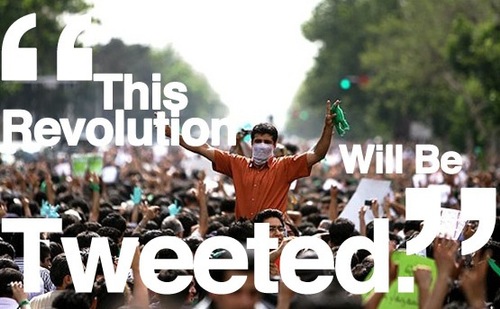
In the last decade, social media has become a powerful asset to the organization and awareness of political activism throughout countries that deal with oppression. The online and public protests in Iran regarding the 2009 presidential election were used in today’s presentation as an example.
The election was controversial, as the candidates represented different political sides of the country. Mir Hossein Mousavi, one of two candidates, was the public favorite as he represented reformist ideals that would overthrow the oppressive government currently in place. When the election was held and votes were counted, the other candidate, conservative Mahmoud Ahmadinejad, had won by a landslide. Immediately there was outcry, not on the streets surprisingly, but online via twitter and blogs.
The sheer volume of tweets was staggering, as at least 25 million people in Iran has access to the Internet and approximately 45 million people have cellphones and use it excessively. Since foreign media was banned, a lot of the revolution could not be televised or covered by international media corporations, so Twitter was the main source of information for the international community outside of Iran.
The protests took place between June 15th, 2009 and Feb 11th, 2010 in the main cities of Tehran and Isfahan. People did go out and protest on the streets, only to be met by violence from police. The presenters had said regarding the outbreak of media attention on Twitter and Facebook that “Through these online outlets, photographs and short films showing police forces beating and bloodying protesters clad in green — the Mousavi campaign’s signature color.” This only encouraged the online media to become more active and spread awareness across the globe.
To see the sheer magnitude of people protesting, see this video.
… And some pictures.
Pete made a good point by mentioning the French and American Revolutionary Wars, and how the public had to use the weapons and tools they could find in order to fight, and how it was similar in Iran. Since it was so dangerous to voice a public opinion physically, online was the most strategic way to protest. The hashtag #iranelection was trending worldwide, and new tweets were coming in from all different kinds of sources. Connecting information and sharing was simple when citizens utilized Twitter during protests. It was vital to the efforts of the protestors and those following the stories in real time.
Press credentials were revoked on June 15th, so in order for people to learn about the protests, they had to resort to the Internet to get the latest on where the authorities were, and what measures were used to detain the crowds. The interactions between the citizens of Iran and the World Wide Web had made a huge impact on how social networking can influence politics and the coverage of a protest through citizen journalism.
This was where many oppressing powers could finally see what power online social networking held in the hands of an unhappy citizen. What capabilities for inciting protest and connecting with others it held within itself. Sites like Twitter have the potential to do something great in mass numbers, and this event is an example of what happens when that potential is used to it’s extent.
The presentation ended with a couple questions…
The first being: Was twitter used to get the word out there or was it used internally (between protestors) as well?
Because of the small population capable of accessing the internet when compared to North America, it was utilized in between protestors, but not to the extent of the international community. But yes, it was used between protestors to organize.
What are the risks for civilians posting these tweets and blogs?
By tracking IP address, the government could be capable of finding a suppressing a citizen whose voice has been heard online, but nothing too drastic considering that would be a lengthy search.
Thanks, Sarah Kirkwood
